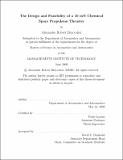| dc.contributor.advisor | Paulo Lozano. | en_US |
| dc.contributor.author | Bruccoleri, Alexander Robert | en_US |
| dc.contributor.other | Massachusetts Institute of Technology. Dept. of Aeronautics and Astronautics. | en_US |
| dc.date.accessioned | 2009-12-10T17:00:35Z | |
| dc.date.available | 2009-12-10T17:00:35Z | |
| dc.date.copyright | 2009 | en_US |
| dc.date.issued | 2009 | en_US |
| dc.identifier.uri | http://hdl.handle.net/1721.1/49883 | |
| dc.description | Thesis (S.M.)--Massachusetts Institute of Technology, Dept. of Aeronautics and Astronautics, 2009. | en_US |
| dc.description | This electronic version was submitted by the student author. The certified thesis is available in the Institute Archives and Special Collections. | en_US |
| dc.description | Includes bibliographical references (p. 103-108). | en_US |
| dc.description.abstract | This thesis discusses the design of a ten milli Newton chemical propulsion system for providing approximately 200 m/s delta velocity to a five kg satellite. The nozzle is the focus of the experimental work, which involves building and testing ten 20x upscale 2D nozzles. The ten nozzles involve three classes, an ideal contour for 2D expansion, a 15 degree cone, and the ideal contour widened for the displacement thickness, each cut to 25%, 50% and 100% axial lengths. The last nozzle is a 100% axial length, ideal contour class, that is twice the thickness to see the effect of end wall boundary layer growth. The nozzles are tested in the MIT Space Propulsions Lab's vacuum chamber at sub atmospheric chamber pressures to match the throat Reynolds number with the micro nozzles. For the purposes of this specific design the Reynolds number is on the order of a 1,000; however, tests are done over a range of 200-1,400 to provide additional data to the community. The nozzle's coefficient of thrust efficiency is approximately 80% for Reynolds numbers greater than a 1,000 and the data suggest the efficiency drops below 50% at 200. The error becomes significant at low Reynolds number due to pressure measurement error, which reduces the quality of the results. The entire system is compared to the state-of-the-art in milli Newton class space propulsion systems and recommendations are given for propellant choice, valve and pump designs, and thermal management. For small delta velocity missions ( 200 m/s), a monopropellant chemical propulsion system is advantageous to current electric propulsion and cold gas thrusters due to the low system mass. | en_US |
| dc.description.statementofresponsibility | by Alexander Robert Bruccoleri. | en_US |
| dc.format.extent | 108 p. | en_US |
| dc.language.iso | eng | en_US |
| dc.publisher | Massachusetts Institute of Technology | en_US |
| dc.rights | M.I.T. theses are protected by
copyright. They may be viewed from this source for any purpose, but
reproduction or distribution in any format is prohibited without written
permission. See provided URL for inquiries about permission. | en_US |
| dc.rights.uri | http://dspace.mit.edu/handle/1721.1/7582 | en_US |
| dc.subject | Aeronautics and Astronautics. | en_US |
| dc.title | The design and feasibility of a 10 mN chemical space propulsion thruster | en_US |
| dc.type | Thesis | en_US |
| dc.description.degree | S.M. | en_US |
| dc.contributor.department | Massachusetts Institute of Technology. Department of Aeronautics and Astronautics | |
| dc.identifier.oclc | 466121647 | en_US |
